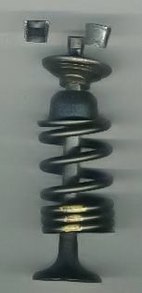A poppet valve (also sometimes called mushroom valve[1]) is a valve typically used to control the timing and quantity of petrol (gas) or vapour flow into or out of an engine, but with many other applications.
It consists of a hole or open-ended chamber, usually round or oval in cross-section, and a plug, usually a disk shape on the end of a shaft known as a valve stem. The working end of this plug, the valve face, is typically ground at a 45° bevel to seal against a corresponding valve seat ground into the rim of the chamber being sealed. The shaft travels through a valve guide to maintain its alignment.
A pressure differential on either side of the valve can assist or impair its performance. In exhaust applications higher pressure against the valve helps to seal it, and in intake applications lower pressure helps open it.
The poppet valve was invented in 1833 by American E.A.G. Young of the Newcastle and Frenchtown Railroad. Young had patented his idea, but the Patent Office fire of 1836 destroyed all records of it.[2]
- ^ A.L. Dyke (1921), Dyke's Automobile and Gasoline Encyclopedia, St. Louis, A. L. Dyke, archived from the original on 2016-06-11
- ^ White, John H. (1979). A History of the American Locomotive. North Chelmsford, MA: Courier Corporation. p. 145.

